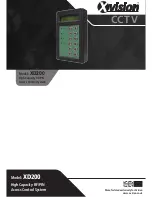
Monitoring Status and Statistics
D-Link
Unified Wired and Wireless Access System
Oct. 2015
Page 474
D-Link UWS User Manual
Command Buttons
The page includes the following buttons:
•
Delete All Neighbors
—Clears all entries from the Neighbor APs and Neighbor Clients list. This deletes all
neighbors for all radios on all APs —
not only for the currently selected AP and radio. The list is
repopulated as neighbors are discovered.
•
Refresh
—Updates the page with the latest information.
Viewing Clients Associated with Neighbor Access Points
The
Neighbor Clients
page shows information about wireless clients that have been discovered by the selected
AP.APs can store information for up to 512 wireless clients. If the information exceeds the capacity, the oldest
data in the neighbor client list is overwritten.
Use the menu above the table to select the AP with the neighbor client information to view. The AP is
identified by its MAC address and location. If the AP has two radios, select a radio to view the neighbor clients
detected via an RF scan on that radio. The radio is identified by its number and configured mode. If the radio
is disabled, the radio mode will be displayed as Off.
The
Delete All Neighbors
button clears the Neighbor AP and Neighbor Clients lists. The list is repopulated as
neighbors and associated clients are discovered.
Table 274: Managed AP Neighbor Status
Field
Description
Neighbor AP MAC
The Ethernet MAC address of the neighbor AP network, this could be a physical radio
interface or VAP MAC address. For D-Link APs this is always a VAP MAC address. The
neighbor AP MAC address may be cross-referenced in the RF Scan status.
SSID
Service Set ID of the neighbor AP network.
RSSI
Received Signal Strength Indication, this is an indicator of the signal strength relative
to the neighbor and may give an idea of the neighbor's distance from the managed
AP. The range is 1–100, where 1 is the weakest signal strength.
Status
Indicates the managed status of the AP, whether this is a valid AP known to the
switch or a Rogue on the network. The valid values are:
• Managed: The neighbor AP is managed by the wireless system.
• Standalone: The AP is managed in standalone mode and configured as a valid AP
entry (local or RADIUS).
• Rogue: The AP is classified as a threat by one of the threat detection algorithms.
• Unknown: The AP is detected in the network but is not classified as a threat by
the threat detection algorithms.
Age
Indicates the time since this AP was last reported from an RF scan on the radio.
















































